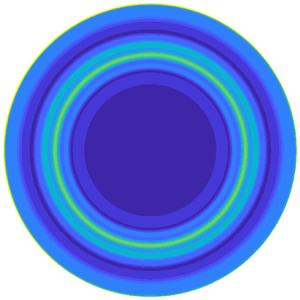Article contents
On the origin of circular rolls in rotor-stator flow
Published online by Cambridge University Press: 27 November 2024
Abstract

Rotor-stator flows are known to exhibit instabilities in the form of circular and spiral rolls. While the spirals are known to emanate from a supercritical Hopf bifurcation, the origin of the circular rolls is still unclear. In the present work we suggest a quantitative scenario for the circular rolls as a response of the system to external forcing. We consider two types of axisymmetric forcing: bulk forcing (based on the resolvent analysis) and boundary forcing using direct numerical simulation. Using the singular value decomposition of the resolvent operator the optimal response is shown to take the form of circular rolls. The linear gain curve shows strong amplification at non-zero frequencies following a pseudo-resonance mechanism. The optimal energy gain is found to scale exponentially with the Reynolds number  $Re$ (for
$Re$ (for  $Re$ based on the rotation rate and interdisc spacing
$Re$ based on the rotation rate and interdisc spacing  $H$). The results for both types of forcing are compared with former experimental works and previous numerical studies. Our findings suggest that the circular rolls observed experimentally are the effect of the high forcing gain together with the roll-like form of the leading response of the linearised operator. For high enough Reynolds number it is possible to delineate between linear and nonlinear responses. For sufficiently strong forcing amplitudes, the nonlinear response is consistent with the self-sustained states found recently for the unforced problem. The onset of such non-trivial dynamics is shown to correspond in state space to a deterministic leaky attractor, as in other subcritical wall-bounded shear flows.
$H$). The results for both types of forcing are compared with former experimental works and previous numerical studies. Our findings suggest that the circular rolls observed experimentally are the effect of the high forcing gain together with the roll-like form of the leading response of the linearised operator. For high enough Reynolds number it is possible to delineate between linear and nonlinear responses. For sufficiently strong forcing amplitudes, the nonlinear response is consistent with the self-sustained states found recently for the unforced problem. The onset of such non-trivial dynamics is shown to correspond in state space to a deterministic leaky attractor, as in other subcritical wall-bounded shear flows.
Information
- Type
- JFM Papers
- Information
- Copyright
- © The Author(s), 2024. Published by Cambridge University Press
References
- 1
- Cited by


